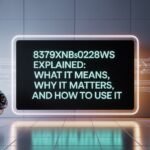Introduction
At first glance, qkfzzu1lbnvinhp4dlhz looks like a meaningless scramble of letters and numbers. But beneath the surface, this code represents something far more significant. In today’s digital environment, strings like qkfzzu1lbnvinhp4dlhz are vital for ensuring security, protecting privacy, and organizing data in ways that humans don’t see but constantly rely on.
From session tokens to encrypted file-sharing links, random identifiers like this keep the internet running smoothly. They prevent predictable patterns, shield sensitive data, and allow platforms to scale to millions of users without chaos.
In this in-depth guide, we’ll explore exactly what qkfzzu1lbnvinhp4dlhz is, why it matters, where you’re most likely to encounter it, the risks it can pose, and how to handle it safely.
What Is qkfzzu1lbnvinhp4dlhz?
Qkfzzu1lbnvinhp4dlhz is a machine-generated alphanumeric identifier. In simple terms, it’s a digital tag created by algorithms to be unique, secure, and practically impossible to guess.
Think of it as a digital fingerprint:
- It carries no obvious meaning to humans.
- It uniquely identifies something for computers.
- It keeps operations efficient and private.
These codes often appear in URLs, authentication tokens, database entries, or secure file-sharing systems. The fact that they are random makes them extremely resistant to guesswork attacks.
Why Systems Use Codes Like qkfzzu1lbnvinhp4dlhz
The internet is a web of identifiers. Without them, services couldn’t separate one user from another or track processes reliably. Codes like qkfzzu1lbnvinhp4dlhz are especially important for:
1. Security and Privacy
Instead of using predictable IDs like “user123” or “file456,” systems rely on randomized strings. This makes it nearly impossible for hackers to exploit sequential patterns.
2. Unique Identification
Every user session, transaction, or uploaded file can have its own unrepeatable code. This prevents mix-ups and allows systems to scale seamlessly.
3. Scalability
Platforms with millions of users need identifiers that don’t overlap. Randomized strings like qkfzzu1lbnvinhp4dlhz can be generated instantly without manual checks.
4. Compliance With Privacy Laws
Modern data protection regulations encourage companies to avoid exposing personal data. Instead of showing names or IDs in URLs, services embed secure codes.
5. Backend Organization
For developers, these identifiers simplify logging, analytics, debugging, and error tracking—without compromising private details.
Real-World Situations Where You See It
Even if you don’t notice, you’ve probably interacted with qkfzzu1lbnvinhp4dlhz-like codes multiple times today.
- Website URLs – Example:
https://platform.com/session/qkfzzu1lbnvinhp4dlhz - Cloud Storage Links – Google Drive, Dropbox, or similar often embed codes for secure file access.
- Email Verification – Password reset links usually carry tokens like this.
- App Session Tracking – Mobile apps use such identifiers to distinguish users without storing sensitive info.
- Private Content Access – Creators may hide content behind unique codes.
Security & Privacy Implications
By itself, qkfzzu1lbnvinhp4dlhz is harmless. The risk comes from where it’s embedded.
- ✅ Safe: When you see it in a legitimate email after requesting a password reset.
- ⚠️ Risky: If it arrives in an unsolicited message urging you to “click now.”
- ❌ Unsafe: When linked to phishing attempts disguised as login or download pages.
The rule: trust the source, not the string.
Why Codes Like qkfzzu1lbnvinhp4dlhz Are Growing in Use
You may be noticing these codes more often because of:
- Privacy-First Tech – Major platforms now hide personal identifiers.
- Explosion of Online Services – More apps = more unique IDs.
- Cloud Storage & File Sharing – Secure links are now standard.
- Exclusive Access Culture – Brands use hidden codes for loyalty perks.
Use Cases Across Different Industries
Finance
Banks rely on randomized tokens like qkfzzu1lbnvinhp4dlhz for transaction verification, fraud prevention, and secure logins.
Healthcare
Medical databases use these strings to anonymize patient data while maintaining unique records.
E-Commerce
Order tracking links and promo codes are often structured as unique identifiers.
Social Media
Platforms embed them in private shareable links for posts, reels, or live streams.
Cloud Computing
Every file or API request can carry a unique identifier to prevent collisions.
Best Practices for Handling qkfzzu1lbnvinhp4dlhz
For Everyday Users:
- Verify sender before clicking links.
- Only use codes when part of a process you initiated.
- Keep security tools (VPN, antivirus, ad-blockers) active.
For Developers:
- Use strong cryptographic randomness for generating IDs.
- Set expiration times for tokens.
- Avoid embedding sensitive data in identifiers.
- Monitor for misuse in logs and analytics.
FAQs
1. What does qkfzzu1lbnvinhp4dlhz mean?
It’s a random, machine-generated code used to uniquely identify something securely.
2. Is it dangerous to see it in a link?
Not inherently. The risk depends on whether the link is legitimate.
3. Why not just use readable names?
Because predictable IDs are easier to hack and don’t scale as well.
4. Where else might I encounter such codes?
In cloud storage, verification emails, session tokens, and secure app functions.
5. Can I generate my own?
Yes—developers use libraries like UUID or cryptographic random generators.
The Future of Identifiers Like qkfzzu1lbnvinhp4dlhz
As technology advances, identifiers will only grow more complex. With blockchain, decentralized IDs, and AI-driven personalization, random codes will evolve into multi-layered, tamper-proof identifiers that serve as the backbone of trust online.
Expect future systems to rely heavily on such codes for digital identity, secure transactions, and even smart contracts.
Conclusion
At first glance, qkfzzu1lbnvinhp4dlhz may look like nonsense—but it’s anything but meaningless. These unique strings are the invisible scaffolding of modern technology. They keep our accounts secure, our data private, and our online experiences smooth.
Whether you encounter qkfzzu1lbnvinhp4dlhz in a file link, an app session, or a verification email, you now understand its purpose. It’s not random noise—it’s a deliberate, secure piece of digital architecture.
The bottom line: trust the source, not the string. If it comes from a legitimate platform you use, qkfzzu1lbnvinhp4dlhz is simply doing its job—keeping the internet organized and secure.

